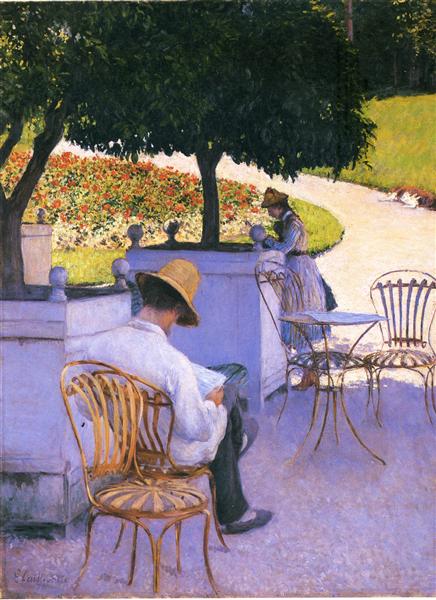Description
In his 1878 painting The Orange Trees or The Artist's Brother in his Garden, Gustave Caillebotte presents a contemplative and intimate scene that reflects both his interest in everyday life and his technical mastery in painting. This work is a remarkable testament to the impressionist style that characterized Caillebotte, although his approach has nuances that distinguish him from his contemporaries, such as Monet or Renoir. Caillebotte, known for his skill in depicting light and space, uses sunlight as a protagonist in this painting that brings the scene to life.
The composition of the work is structured in an almost photographic manner, a distinctive characteristic of Caillebotte. The garden opens up before us with its lush vegetation, impressing the richness of the orange trees present. The chosen perspective places the viewer at a slightly elevated angle, offering a view of the garden that seems to extend across the surface of the canvas. This compositional choice not only frames the stillness of the moment, but also allows the various green tones that dominate the palette to be appreciated, symbolizing the vitality of nature and the pleasant atmosphere that surrounds it.
A fascinating character of the painting is the presence of the artist’s brother, a human element that brings a sense of personal narrative to the composition. The male figure is shown sitting in the little garden, motionless but immersed, as if in silent meditation. His clothing, in dark tones, contrasts with the brightness of the surroundings, suggesting both his connection to the earth and his position in this moment of relaxation and family connection. This depiction of the brother denotes the importance of family in Caillebotte’s life, revealing the influence of his personal ties on his artistic work.
Colour plays a crucial role in this composition, not only evoking a bright and vibrant environment, but also creating a calm and contemplative atmosphere. The orange trees, with their orange and green hues, bring a warmth that intertwines with the freshness of the leaves and the daylight that bathes them. In addition, the contrast of these colours is complemented by the earth, creating a visual effect that resonates with the garden theme, a symbol of fertility and growth.
Caillebotte is often remembered for his innovative use of spacing and perspective techniques, excelling in depicting scenes of everyday life. In The Orange Trees, his ability to capture a simple yet significant moment resonates with the Impressionist tradition, while bringing his own personal touch through careful observation of the intersection between humans and nature. This work serves as a reminder of the tranquility that can be found in the intimacy of home and family, emphasizing the slow pace of life that is often lost in modernity.
As we explore “The Orange Trees,” it becomes clear that this piece is much more than a simple representation of a garden. It is a manifestation of Caillebotte’s love and appreciation for everyday moments, for the beauty of nature, and for family ties that, in their simplicity, can be deeply meaningful. Ultimately, the work invites us to reflect on the serenity that can be found in contemplation and the simplicity of the environment we inhabit. Caillebotte manages, through his vibrant palette and intimate composition, to echo the essence of life in its most fundamental forms, turning the garden into a living space where nature and humans intertwine in a complicit and lasting embrace.
KUADROS ©, a famous painting on your wall.
Hand-made oil painting reproductions, with the quality of professional artists and the distinctive seal of KUADROS ©.
Painting reproduction service with satisfaction guarantee. If you are not completely satisfied with the replica of your painting, we will refund 100% of your money.

